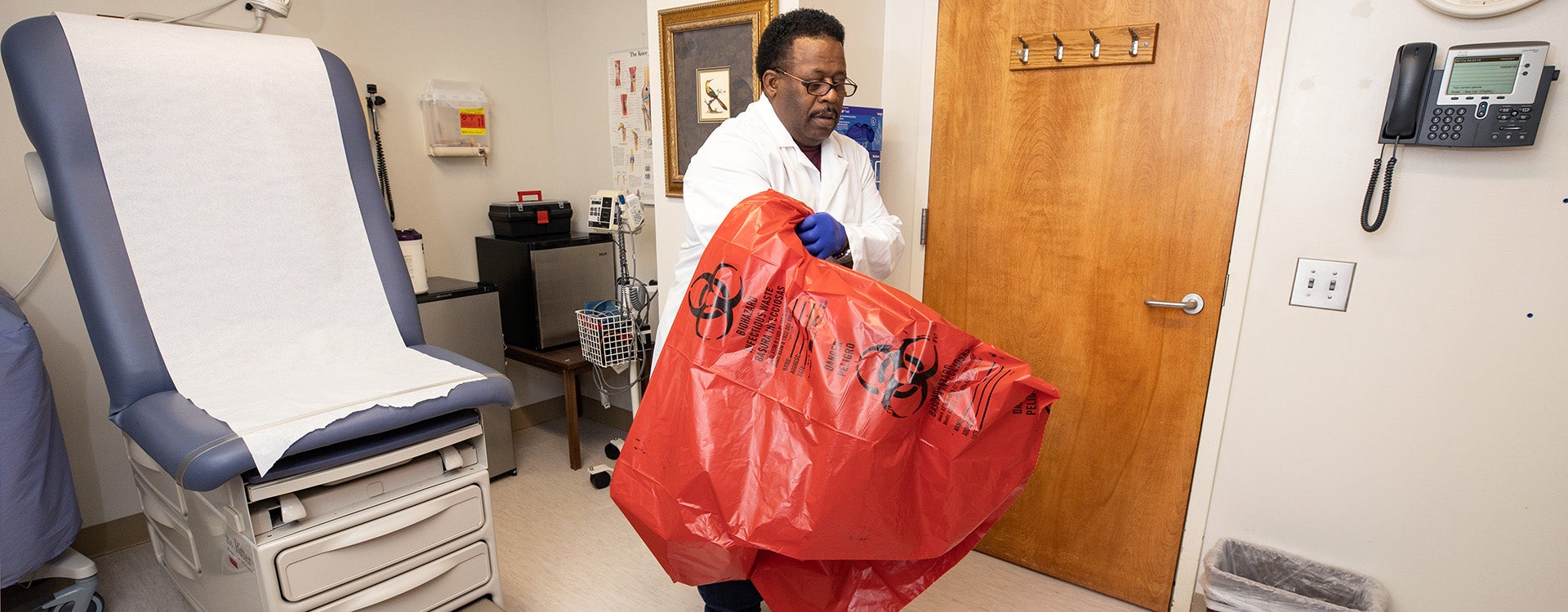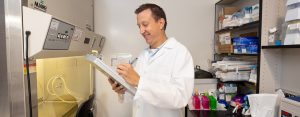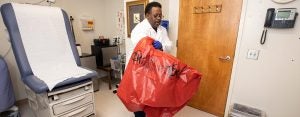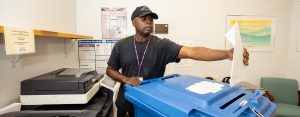Biological Safety
Biological Waste Management
Our biological waste management division schedules pickup and disposal of biomedical waste and regulated (red bag) waste and sharps.
Biological Waste Pick Up Contacts
- For Radioactive Waste pick up, call 252-744-3867 and press #1.
- For HIPAA-Compliant Clinical Confidential Document pick up, call 252-744-3867 and press #2.
- For Biological Waste pick up, call 252-744-3867 and press #3.
- For other questions, call 252-744-9092.
Biohazardous Materials Use
Biohazardous Materials include:
- Allergens
- Biotoxins
- infectious agents/microorganisms
- Human blood, tissue or cell lines
- Knock-out or transgenic animals
- Recombinant DNA in plants or symbionts
- Recombinant DNA or RNA
- Transgenic plants
All individuals are required to file a registration with the Office of Prospective Health/Biological Safety, if they wish to work with a covered biohazard (biotoxins, allergens, biohazardous agents, microorganisms with an assigned biosafety level 2 or higher, human tissues, body fluids and commercially available human cell lines, any recombinant DNA or synthetic genomics work or use of viral vectors, or Select Agents). Use or breeding of knock-out or transgenic animals may require registration to meet NIH Guidelines.
NIH
- Adsat-Adenovirus-Vector-Containment
- Biosafety Considerations for Research with Lentiviral Vectors
- Experiments that are Exempt from the NIH Guidelines
- FAQs-Major Actions under NIH Guidelines
- Investigator Educational Brochure Recombinant-DNA1
- Lenti-Lenti-Virus-Containment-Guidance
- NIH Guidelines for Research Involving Recombinant DNA Molecules
- Session-III-Synthetic-Genomis-Issues
- State-of-the-Art-Lentiviral-Vectors-for-Research-Use-Risk-Assessment-and-Biosafety-Recommendations
- Transgenic-Animals-and-the-Use-of-Recombinant-DNA-in-Animals
- Transgenic-Transgenic-Plants
- Overview of the NIH Guidelines for Research Involving Recombinant or Synthetic Nucleic Acid Molecules
- Overview of the NIH Guidelines Requirements for Institutional Biosafety Committees Under the NIH Guidelines
Biological Safety Cabinets
All biological safety cabinets at East Carolina University must be certified annually.
Basic certification includes: leak testing HEPA filters, checking air inflow and exhaust rates in the cabinet, noise and vibration tests, as well as checking light levels inside the cabinet on the work surface.
Cabinets are to be certified when they are newly installed, annually, or if moved to a different location. If your cabinet needs certification, or if you believe it may not be operating properly, contact the Biological Safety Officer (252-744-3437).
- Biological Safety Cabinet Decision
- Biological Safety Cabinets
- Biological Safety Cabinets and Laminar Flow Hood Certificate Costs
- Working in a Biosafety Cabinet (Video)
Documents
- Biosafety Manual (PDF)
- Biohazardous Waste Disposal Procedures (PDF)
- Biohazardous-Waste-Disposal-Standard-Operating-Procedures-and-Satellite-Accumulation-Storage-Areas-7-28-24
- Biowaste and confidential documents (PDF)
- BMBL-5th-Edition
- ECU Hazardous Material Transportation Security
- ECU Principle Investigators – New-Students Memo
- HIPAA Confidential Documents (PDF)
- New Lab Students/Staff Immunization Requirements (PDF)
- Triangle Certification Rate Increase Memo (PDF)
IBC Meeting Dates
- January 16 (Deadline January 08, 2025)
- March 13 (Deadline March 5, 2025)
- May 8 (Deadline April 30, 2025)
- July 17 (Deadline July 9, 2025)
- September 18 (Deadline September 10, 2025)
- November 20 (Deadline November 12, 2025)
Signs and Labels/Stickers
Forms
- Registration for the Use of Biohazardous Agents Form (DOCX)
- Biological Safety Committee Roster
- Request for the use of Recombinant Plants or rDNA in Plants
- IBC Amendment Form
- Attestation/Certificate of Online Training Completion Form
- Assessment-Prospective-Health-Review
Training Slides and Videos
- Biological-Safety-Training
- Biological Safety Cabinets: How they Work to Protect You (Video)
- Cleaning up Spills (Video)
- Overview of The NIH Recombinant DNA Guidelines
- Overview-of-the-NIH-Guidelines for Research involving Recombinant DNA Molecules – From the NIH viewpoint
- Principles_of_Biosafety
- Safe Use of Autoclaves and Proper Waste Disposal
- ASU Autoclave Training (Video)
- Working at Animal Biosafety Level 1
- Working at Animal Biosafety Level 2
- Working at Animal Biosafety Level 3
Hazardous Material Transportation General Security Awareness – Saf-T-Pak/IATA Training Requirements
Shipping Division 6.2 Dangerous Goods Compliance Training**
**New Users use this link for Hazardous Material Transportation General Security Awareness (Saf-T-Pak Training): www.apps.saftpak.com
- Hazardous Material Transportation General Security Awareness – Saf-T-Pak/IATA training is required every two years for anyone shipping dangerous goods through IATA. Dangerous goods are defined as articles or substances which are capable of posing risk to health, safety, property or the environment. If your position requires you to ship any dangerous goods through IATA, you need training.
- You may be exempt from this training depending on what you actually ship (See Shipping Categories below).
Shipping Categories Which Require Training
Feel free to contact our biosafety office to obtain a copy of our “Dangerous Goods Packaging, Labeling, and Declaration Checklist” available on loan as well as consultant resources with clinics and labs involved in shipping to answer your questions. Contact numbers for this information include 252-744-3437 or 252-744-2237.
- Category A substances: An infectious substance which is transported in a form that, when exposure to it occurs, is capable of causing permanent disability, life threatening or fatal disease in otherwise healthy humans or animals.
- Category B substances: An infectious substance which does not meet the criteria for inclusion into category A (example, patient samples in which it has not been determined if they contain an infectious substance or not)
- If you ship genetically modified organism or micro-organisms
You may be exempt from this training if: Exempt status can only be used for direct patient specimens. Direct patient specimens are those collected directly from the human or animal which have been determined by a professional to have minimal likelihood of containing a pathogen. If the specimen is cultured after collection, it can no longer be considered a direct patient specimen.
Please review the list of Category A substances and flow chart below to determine whether or not you need training. If you follow the flow chart and end up at any of the UN boxes at the bottom, then this training is required for you. If you have any questions please don’t hesitate to email or call Chad Spruill or John Baumgartner at 252-744-2070.
Links
American Biological Safety Association
American Society for Microbiology
CDC Links
CDC/NIH
Information Links
- Biological Indicator Spore Testing Procedure (DOCX)
- Bloodborne Pathogen Training Information
- State-of-the-Art Lentiviral Vectors for Research Use – Risk Assessment and Biosafety Recommendations (PDF)





